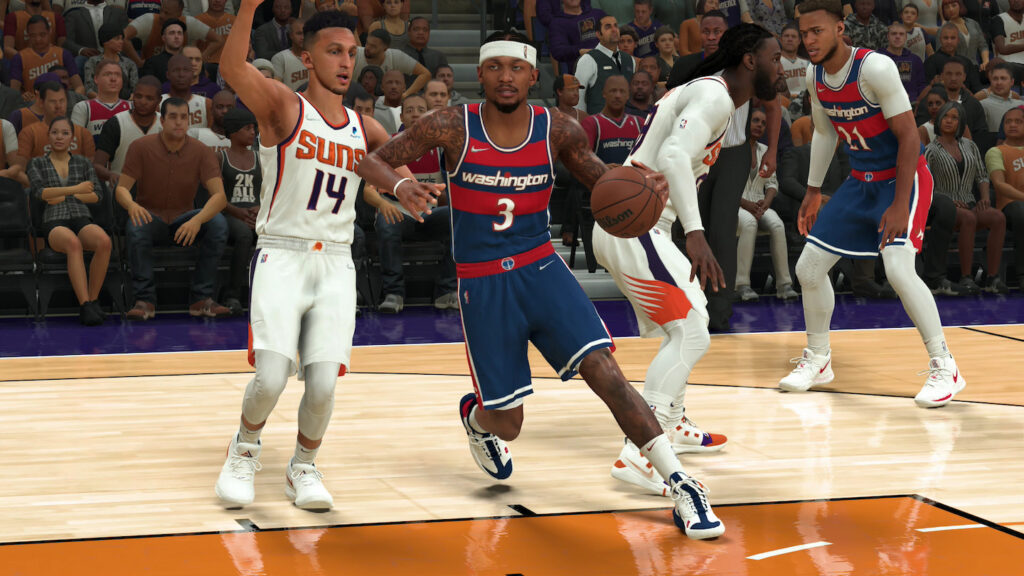The Wizards started the 2021-22 NBA season with an impressive 10-3 record. They’ve gone 5-12 since then. What went wrong?
The Washington Wizards fell 118-98 to the Phoenix Suns on Thursday night. The defeat marked their fourth straight loss — their first four-game losing streak of the season — and keeps them winless through three games of their six-game road trip.
Washington has seen better days this season, just as recently as mid-November. Their 105-100 win over the New Orleans Pelicans on Nov. 15 bolstered the team’s record to 10-3. They ended that night sitting atop the Eastern Conference in first place.
Sadly, the Wizards were unable to uphold that standing. Since then, the team has gone 5-12. With a 15-15 overall record, Washington now sit seventh in the East.
Naturally, the big question is “What went wrong”? How did the Wizards go from top of the East to Play-In Round Contention in a month’s time?
First, let’s dive into the per 100 ratings. Through the first 13 games, the Wizards were 16th in the NBA in offensive rating (107.5), fourth in defensive rating (102.7), and sixth in net rating (4.8). In the 17 games since, Washington has plummeted to 25th in offensive rating (106.6), 27th in defensive rating (115.3), and 27th in net rating (-8.8).
When seeking out the culprits behind such a stark contrast, three team-level stats stuck out to me as well as the production of three players that were key to getting the Wizards’ engine running.
The first thing that jumped out to me was Washington’s pull-up shooting numbers. Now, the Wizards have not been a reliable 3-point shooting team at any point this season. They shot 33.7 percent from beyond the arc through the first 13 games (20th in the league) and 31.3 percent through the last 17 (26th). However, during The Good Times, they were able to keep opponents honest with some excellent shooting off the dribble.
Washington’s 49.4 effective field goal percentage on pull-up jumpers through their first 13 games was the second-best mark in the NBA. That number fell off a cliff in the last 17 games, dropping to 40.4 percent, 26th in the league.
Those pull-up numbers were particularly important because the Wizards’ catch-and-shoot numbers were equally bad in both windows. Washington placed 24th in catch-and-shoot effective field goal percentage over both timespans.
Another glaring difference between 10-3 and 5-12 is their inability to start games off on the right foot. The Wizards’ plus-minus splits by quarter was 0.3/0.8/3.5/0.0 through the first 13 games, but -2.5/-4.8/-1.6/0.0 through the latter 17.
In the early going, Washington would grapple with opponents in the first two quarters before kicking it into overdrive in the third. Since then, there hasn’t been any first half grappling. Their -7.4 first half plus-minus over their last 17 games is the second-worst in the league. The Wizards quickly fall behind, and they’re rarely able to get back into the game.
Thirdly, their paint defense has slipped over time. Washington allowed 45.8 points in the paint per game through the first 13 games, 16th in the league. That increased to 51.8 points per game and dropped to 29th in the league over the last 17 games.
Those three things are certainly a recipe for a slump in the standings, but the issues have also come on an individual level. To be clear, those issues do not extend to Bradley Beal. Beal’s production has actually improved between time windows. He averaged 23.3 points on 40.7 percent shooting with 5.6 assists and 4.0 turnovers per game during the first 13 games. During the last 17 Beal has averaged 22.5 points on 48.2 percent shooting with 5.9 assists and 3.2 turnovers per game.
Instead, it’s the top three players behind Beal that suddenly started struggling. Montrezl Harrell was the second-leading scorer during the first 13 games, averaging 18.0 points, 8.5 rebounds, and 1.0 blocks per game. However, his production plummeted to 11.9 points, 6.9 rebounds, and 0.4 blocks since then.
Spencer Dinwiddie, the third-leading scorer early on, was humming along as the new starting point guard in the Nation’s Capital. He started the year averaging 17.0 points on a .429/.377/.944 shooting split and 6.0 assists per game. That has since dropped to 8.8 points on a .328/.268/.727 split and 4.3 assists per game.
Lastly, there’s Kyle Kuzma. Kuzma averaged 14.5 points and 9.1 rebounds while shooting 37.1 percent from 3-point range in the first 13 games. Those averages have dropped to 11.3 points, 7.0 rebounds, and 30.9 percent from 3 in the last 17. However, there is some solace in Kuzma’s assist and free throw shooting numbers. Kuzma improved from 1.9 assists to 3.8 assists per game between windows, and 51.7 percent to 79.3 percent shooting from the line.
So how did the Washington Wizards fall off the map after being in first place a month ago? A massive drop in scoring production from the top three players behind Bradley Beal, a complete power outage with scoring off-the-bounce, and starting games unready to compete. Restoring their shooting touch and hunger could remedy their issues. As their road trip continues, we’ll see if the Wizards make any changes before they fall deeper in the standings.


More Stories
Knicks Dominate in Inaugural ABC Wednesday Matchup
The Impact of Having Zach Back
Friday Morning Point Guard